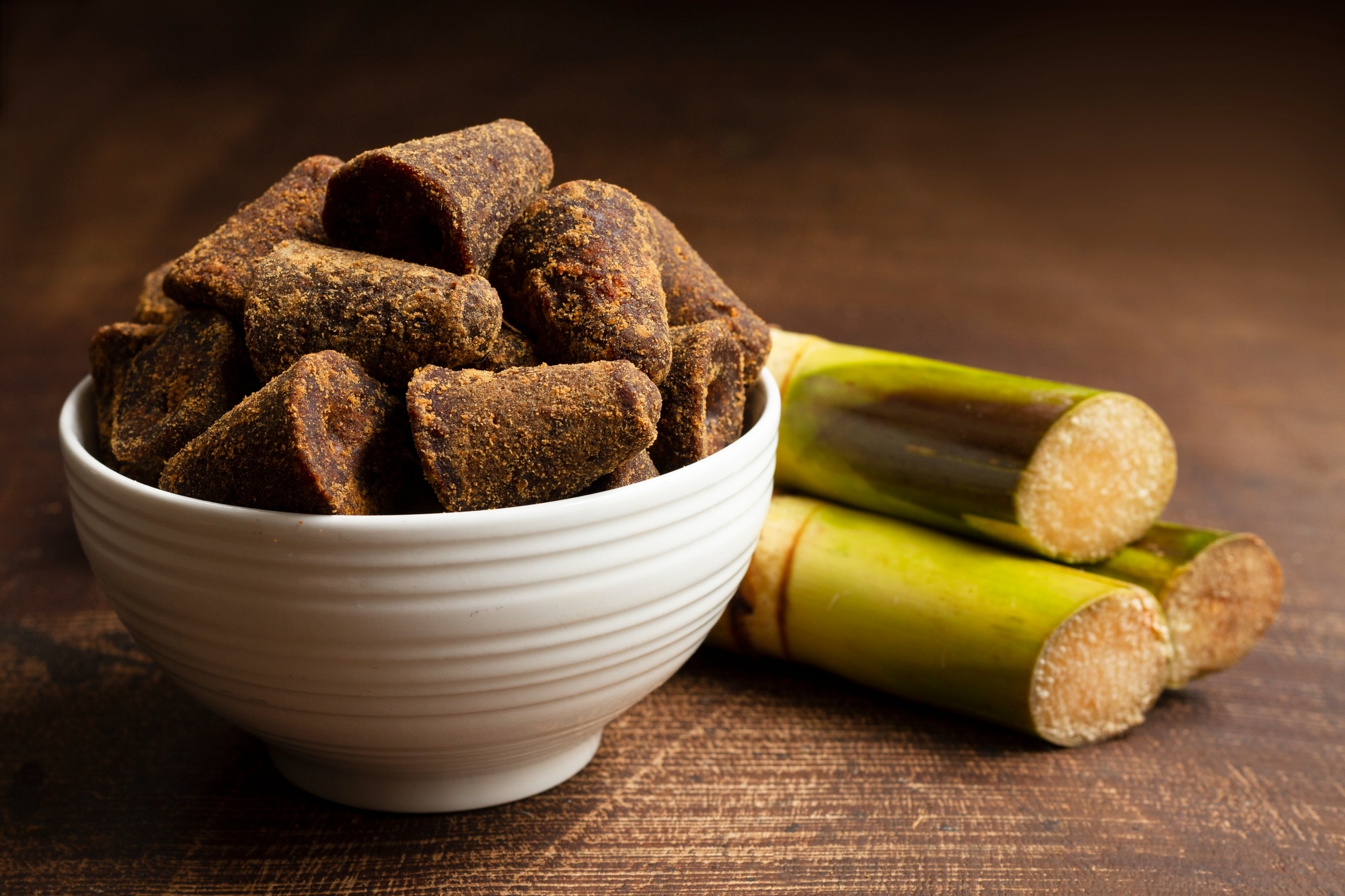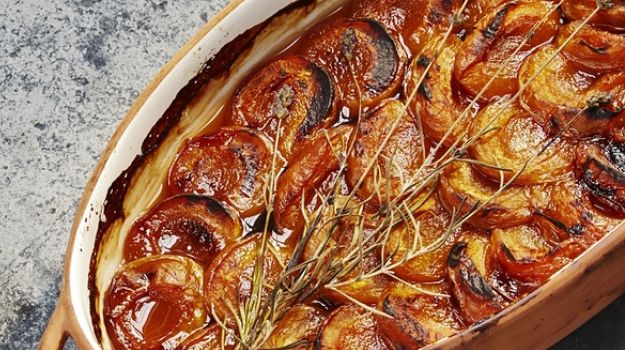Apricots baked with vanilla, cinnamon and lavender. Photograph: Tessa TraegerLeek vinaigrette, salmon with fennel, lemon and dill and a Russian salad - Sally Clarke’s recipes combine simple ingredients to make stunning dishes.
Apricots baked with vanilla, cinnamon and lavender
Apricots cannot be "half baked" " the cut surfaces discolour easily and turn a rather nasty brownish-grey if the heat has not fully penetrated the fruit, so a soft, slightly melted look is what should be aimed for.
Serves 6
apricots 650g
vanilla pod 1, cut in 2 lengthwise
white wine 150ml
caster sugar 100g
water 150ml
cinnamon stick ½, lightly broken
lavender sprigs 10-12 (keep 6 of the best for decoration)
Wash and remove stems of the apricots and pull apart at the natural line. Place snugly in a terracotta or ovenproof dish (ideally the one you will serve them in) skin sides down. The fruits should be slightly overlapping at this stage as they will shrink a little on baking.
Preheat the oven to 180C/gas mark 4. In a small pan bring the remaining ingredients (except the lavender decoration) to a rolling boil for a few minutes. Pour the entire contents of the pan over the apricots and cover with aluminium foil.
Bake for 20-30 minutes, then remove the foil and continue to bake for a further 5-10 minutes or until the apricots are soft and the syrup has become deliciously fragrant. Remove the lavender and cinnamon shards for ease of serving. Arrange the fresh lavender sprigs as decoration.
Russian salad " beetroot with potatoes, turnips, carrots and peas
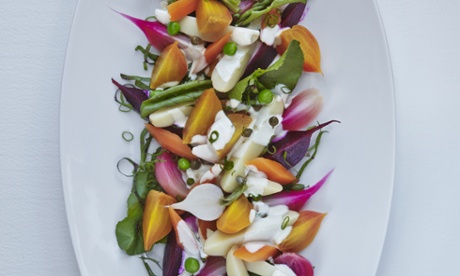
You will not be surprised to learn that this version is far removed from the pallid and unappetisingly presented concoction often found in tins on some supermarket shelves and that which may have featured in some past school lunch nightmares. If the beetroot leaves are fresh and still pretty, use them as well.
Serves 6
baby potatoes 300g
carrots 200g, small
young turnips 150g
beetroot 200g, small, various colours if available
bay leaves 2
fresh peas 100g (podded weight)
Dijon mustard 2 tsp
horseradish 1 tbsp, freshly grated
lemon juice 1 tbsp
mayonnaise 250ml (see below)
salt and pepper
baby capers a few
spring onions a few, trimmed and washed
olive oil 3 tbsp
red wine vinegar 1 tbsp
watercress a bunch, washed, spun and thick stalks removed
For the mayonnaise
egg yolks 2
light olive oil 250ml
lemon juice of 1 small
salt and pepper
chives ½ bunch, finely chopped
To make the mayonnaise, beat the yolks together in a small bowl until smooth. Gradually add the olive oil, drop by drop while continually beating, until the mixture has emulsified. If it curdles, try beating an ice cube into the mix; if this fails, start with a clean bowl, a fresh egg yolk and beat the curdled mixture in little by little as before. Add the lemon juice, and salt and pepper to taste. Leave covered in a cool place until ready to serve. Fold in the chopped chives just before serving. (This recipe will act as the perfect base of many a mayonnaise.)
Wash the potatoes and peel the carrots and turnips. Halve or quarter the potatoes depending on their size, slice the carrots on an angle and cut the turnips into small wedges. Scrub the beetroots, remove the leaf end and any root tendrils still attached and boil in salted water until tender. Cool in the water, peel and slice into small wedges. (Keep the water if making a beetroot or tomato soup within a few days.) Keep the beetroot separate from the other vegetables until the salad is assembled, as it will stain.
Cook the potatoes in salted water with the bay leaves until almost tender, remove with a slotted spoon and leave to cool. Next cook the turnips in this water, in the same way and remove, then the carrots.
Cook the peas in fresh boiling salted water, drain and chill immediately in iced water. Mix the mustard, freshly grated horseradish, lemon juice and mayonnaise together and season to taste. It should be packed with flavour. Take half the dressing and mix with chilled water until the consistency of single cream. Slice the spring onions finely, keeping the green separate from the white part. Mix the potato, carrot, turnip and capers into the dressing with the white of the spring onion.
Finely shred the beetroot leaves (if any) and jumble with the beetroot, olive oil, salt, pepper and red wine vinegar, and scatter on a plain white plate. Pile the potato salad over the top, scatter with the green spring onion, then the drained peas. If the salad is assembled in this order, and carefully, the effect will be both colourful and pretty.
Serve with a side salad of green or red watercress leaves and offer the remaining horseradish mayonnaise separately.
Leek vinaigrette with chopped egg, chives and mustard dressing
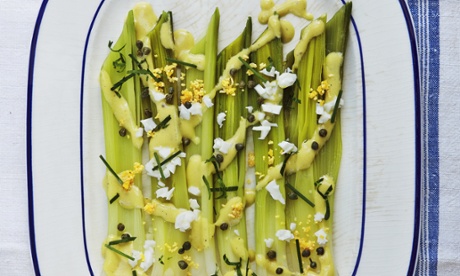
A lovely dish to serve with cold sliced ham, or as part of a selection of old-fashioned hors d'oeuvres.
Serves 6
leeks 6 small
Dijon mustard 2 tsp
wine vinegar 2 tbsp
salt and pepper
light olive oil 5 tbsp
eggs 3
chives 1 tbsp, long chopped
small capers 1 tbsp
parsley 2 tbsp, roughly chopped
Choose even-sized small (not baby) leeks, trim away the dark green ends and peel off the outside layers. Rinse, cut in half lengthwise and rinse again very well. Cut each half to the same length, approximately 10cm. Use the trimmings for soup or stock.
To make the dressing, whisk the mustard with the wine vinegar, salt, pepper and light olive oil.
Hard boil the eggs by placing them in a small pan, covering with cold water and bringing them to the boil. Cook for 7 minutes then rapidly cool them under cold running water. Peel and cut open the eggs, remove the yolks and crumble or push through a wide-gauged sieve. Chop the egg white roughly.
Bring a pan of salted water to the boil and cook the leeks gently until tender. Drain carefully and remove them to a serving platter, lining them next to each other, cut sides up. Pour the dressing over the warm leeks and leave to cool.
To serve, scatter the egg white over, then the yolk, then finish with lots of chives, capers and parsley.
Salmon with sliced fennel, lemon and dill
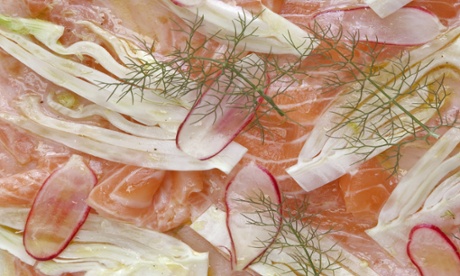
Some, if not all, of the best dishes in the world are the least complicated and this is a classic example of how tempting and beautiful a few fresh ingredients can be when they are carefully assembled at the last minute, with an eye on quality and provenance.
Serves 6
salmon fillet 450g, wild or organically reared
fennel bulb 1 medium, washed
radishes 1 small bunch
dill 1 small bunch, stems removed
lemon juice of 2
olive oil 4 tbsp
salt and pepper
lemon 1, cut into 6 wedges
Ask your fishmonger to pin-bone the salmon for you if you are unable to do this yourself. This is essential as you will be slicing the fish raw and cardboard (not paper) thin. Any stray hair bones will drag with the knife and the slices will rip as you cut, so it needs to be done correctly. Freeze or chill the fish in a fridge for up to 20 minutes to make the slicing easier.
Trim the fronds from the fennel bulb and chop finely. Remove the outside leaves and use for another recipe (soup, stock, stew). Cut the fennel heart in half lengthwise and, with the cut surface face down, slice as finely as possible in long slices. Wash and trim the radishes and slice very finely from top to bottom. Pick a few beautiful dill sprigs and roughly chop the rest.
Place both the fennel and radishes in a bowl with the chopped fennel tops and chopped dill and chill until ready to assemble.
With the skin of the salmon flat on the cutting board, and with a very sharp, long, thin-bladed knife, slice the salmon thinly, slightly at an angle towards the skin. Do not allow the knife to cut through the skin; instead, angle the knife so that it just scrapes above it as the slice is released each time. Place the slices one by one onto a flat serving platter, either spread out flat or slightly overlapping.
This may now be covered tightly with clingfilm and left in the fridge for up to 2 hours, or finished immediately (which is preferable).
Toss the fennel and radishes with the lemon juice, olive oil, salt and pepper until well coated. Do not worry if there seems to be too much dressing as this will also act as the marinade for the fish. (As the lemon juice and the acidity of the olive oil touch the fish, they will start to "cook' it, thus tenderising it slightly.)
Scatter the vegetables over the fish lightly and evenly, then drizzle the remaining juices over and around.
Garnish with lemon wedges and reserved dill sprigs and serve with granary bread or rye toasts.
Open cep omelette with thyme and creme fraiche
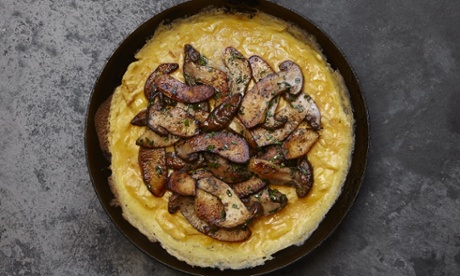
Never wash a cep, always brush or wipe with a damp cloth. Trim the base of the dry stalk or base if necessary with a small knife, then remove any sand or leaf or slug with a mushroom brush.
Serves 6
ceps 250g
butter 100g
thyme 2 tsp, chopped
salt and pepper
parsley 1 tbsp, chopped
eggs 12
full cream milk 100ml
creme fraiche 150ml, room temperature is best
Prepare the ceps as described above, trimming away any discolouration or sandy parts. Slice or wedge the ceps into even-sized pieces. In a medium-sized omelette pan heat half the butter until foaming and saut"é the ceps quickly with the thyme, and a little salt and pepper. Add the parsley and remove all with a slotted spoon to a small bowl, leaving the mushroom juices in the pan. Add the remaining butter to the pan and remove from the heat.
In a bowl beat the eggs with a fork, with a little salt and pepper and the milk. Place the pan back on the heat and when the foaming butter begins to subside, pour in the eggs. With a wooden spoon gently move the cooked egg into the centre of the pan, little by little. When it is almost cooked to your liking scatter the ceps over the surface and as soon as the omelette has set, slide onto a warm plate.
Serve immediately with teaspoonfuls of creme fraiche and warm crusty bread.
Tomato salad with nectarines and feta
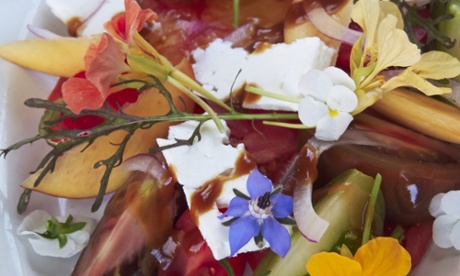
Each summer holiday in France during my childhood, the same classic tomato salad seemed to be found wherever we went " whether it was to a roadside cafe or on the table of a family meal in the countryside: ripe, juicy, bright red tomatoes, roughly sliced and scattered flat over a plain white plate, covered in equally roughly cut red onions and dressed with astringent red wine vinegar, olive oil, salt and finished with a big handful of chopped parsley. I love this salad for its simplicity and rusticity but sometimes one wants something a little more or something just one step on. Nectarines are normally found in the markets at the same time as tomatoes, and I am a great fan of fruits in salads. Crumble feta or ricotta over this salad, and then scatter with blossoms such as nasturtium, rocket flowers or marigold petals
Serves 6
ripe tomatoes 650g, plum, beefsteak or heritage variety
ripe nectarines 2
red onion 1 medium
feta or ricotta 200g
Dijon mustard 2 tsp
red wine vinegar 1 tbsp
salt and pepper
olive oil 4 tbsp
parsley 2 tbsp, roughly chopped
flower blossoms such as nasturtium, rocket flowers or marigold
Take 3 or 4 different types of tomatoes, chosen for their colours and shapes. Cut them in slices or wedges and scatter them over a flat serving dish.
Slice the nectarines from the stone in wedges and place them in and around the tomatoes.
Cut the red onion in half and then in paper thin slices across, making half rings. Sprinkle this on top and add shavings of feta or crumbled ricotta.
Place the mustard, red wine vinegar, salt and pepper in a bowl and whisk with a fork until blended. Gradually add the olive oil until it is to your taste. Spoon this dressing over and around the salad and scatter with the chopped parsley.
Finish with beautiful blossoms if you have any and eat as soon as possible.
Extracted from Sally Clarke: 30 Ingredients by Sally Clarke (Frances Lincoln, "£25). Click here to order a copy for "£20 at the Guardian Bookshop




